人教版(2019)必修第一册Welcome Unit Discovering Useful Structures(共26张ppt)
文档属性
| 名称 | 人教版(2019)必修第一册Welcome Unit Discovering Useful Structures(共26张ppt) | 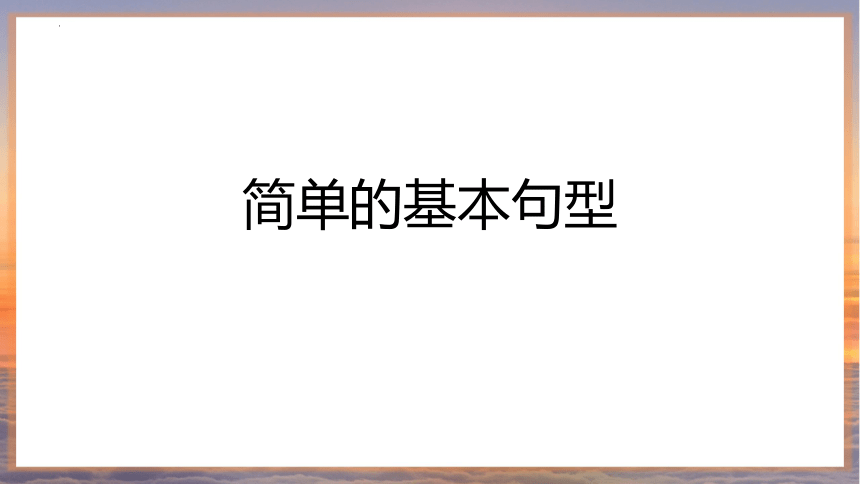 | |
| 格式 | pptx | ||
| 文件大小 | 170.8KB | ||
| 资源类型 | 教案 | ||
| 版本资源 | 人教版(2019) | ||
| 科目 | 英语 | ||
| 更新时间 | 2023-09-22 19:56:37 | ||
图片预览

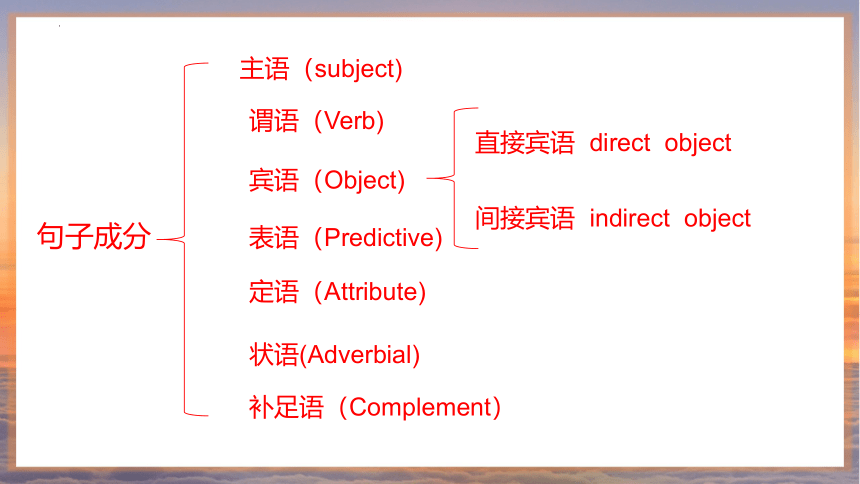
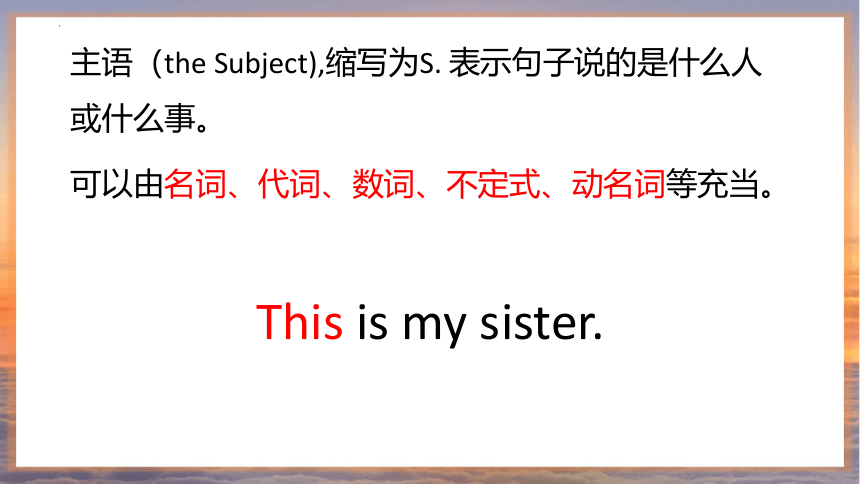
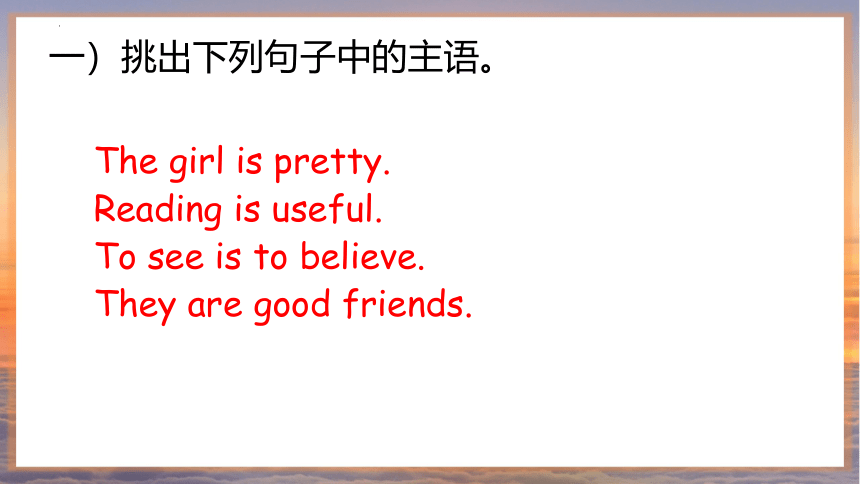
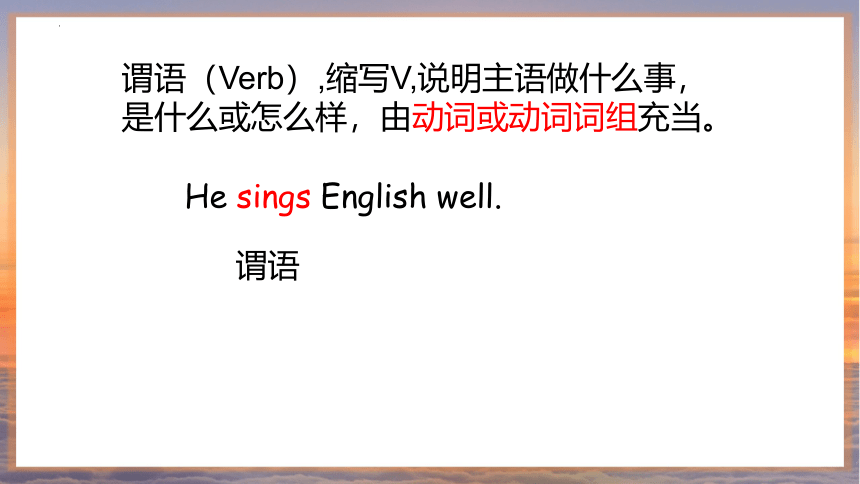
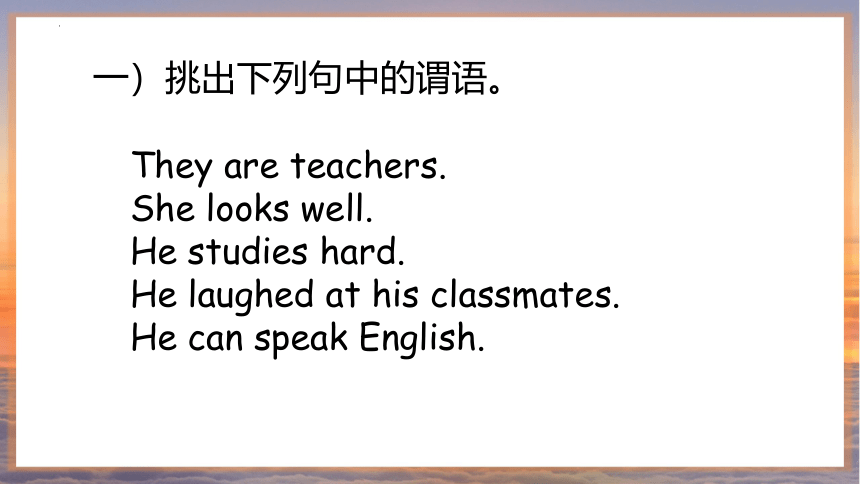
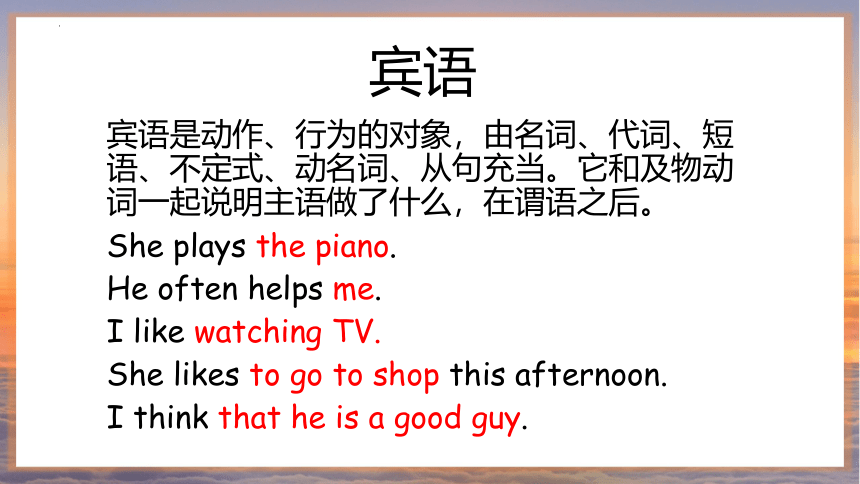
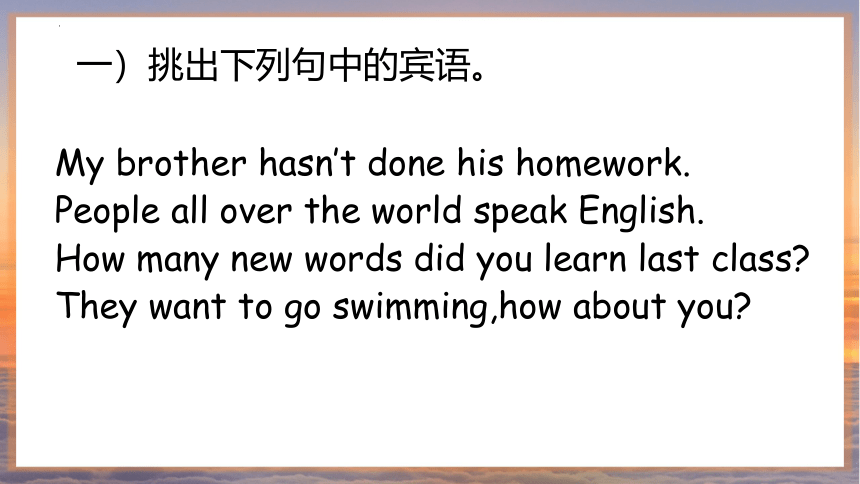
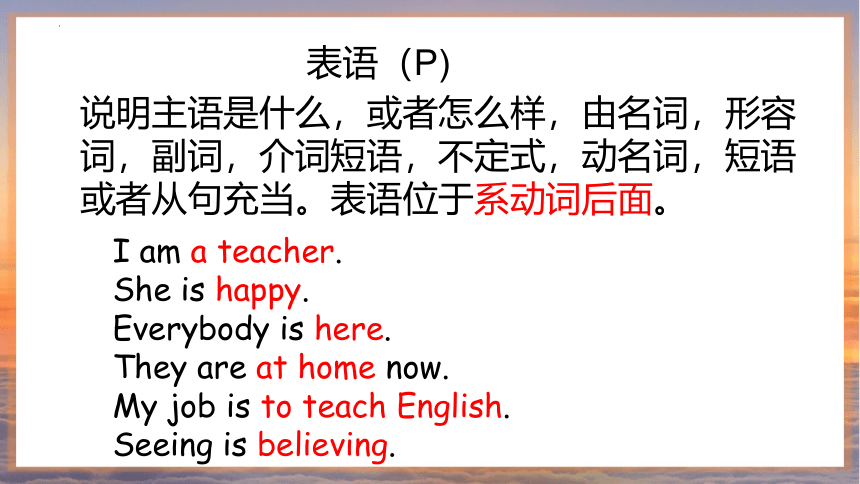
文档简介
(共26张PPT)
简单的基本句型
句子成分
主语(subject)
谓语(Verb)
宾语(Object)
表语(Predictive)
定语(Attribute)
状语(Adverbial)
补足语(Complement)
直接宾语 direct object
间接宾语 indirect object
This is my sister.
主语(the Subject),缩写为S. 表示句子说的是什么人或什么事。
可以由名词、代词、数词、不定式、动名词等充当。
一)挑出下列句子中的主语。
The girl is pretty.
Reading is useful.
To see is to believe.
They are good friends.
He sings English well.
谓语
谓语(Verb),缩写V,说明主语做什么事,是什么或怎么样,由动词或动词词组充当。
一)挑出下列句中的谓语。
They are teachers.
She looks well.
He studies hard.
He laughed at his classmates.
He can speak English.
宾语
宾语是动作、行为的对象,由名词、代词、短语、不定式、动名词、从句充当。它和及物动词一起说明主语做了什么,在谓语之后。
She plays the piano.
He often helps me.
I like watching TV.
She likes to go to shop this afternoon.
I think that he is a good guy.
一)挑出下列句中的宾语。
My brother hasn’t done his homework.
People all over the world speak English.
How many new words did you learn last class
They want to go swimming,how about you
表语(P)
说明主语是什么,或者怎么样,由名词,形容词,副词,介词短语,不定式,动名词,短语或者从句充当。表语位于系动词后面。
I am a teacher.
She is happy.
Everybody is here.
They are at home now.
My job is to teach English.
Seeing is believing.
一)挑出下列句中的表语。
The old man was feeling very tired.
The leaves have turned yellow.
They all became interested in the subject.
宾语补足语
在英语中,有些句子只有宾语并不能表达完整的意思,必须在宾语后面加上宾语补足语才能表达完整的意思。它起补充说明宾语干什么,怎么样的作用。
If you let me go, I’ll make you king.
Leave the door open.
We found him out when we arrived.
一)挑出下列句中的宾语补足语。
He found it difficult to do the work.
They call me Lily.
I saw Mr. Wang got on the bus.
1.主语+谓语(S+Vi)
不及物动词:本身意思完整,后不需要加宾语的动词。
They played. 他们玩耍。
I sing. 我唱歌。
主语
谓语
及物动词
不及物动词
hate
love
come
jump
主语+谓语(介词+宾语)
I wait for my favourite song.
I listen to the radio.
介词
2. 主语+谓语+宾语 (S+V+O)
He breaks her heart.
I love the songs.
主语
发出者
谓语
动作
宾语
承受者
3. 主语+谓语+宾语+宾语(S+V+IO+DO)
He gives me a book.
He shows me his pen.
主语
谓语
间接宾语
直接宾语
人
物
谓语+间接宾语(sb)+直接宾语(sth)
谓语+直接宾语(sth)+ to/for + 间接宾语(sb)
My father gives me a hug.
My father gives a hug to me.
My mother cooks us a meal.
My mother cooks a meal for us.
带双宾语的及物动词,如果把直接宾语放在间接宾语之前,必须加上to 或for.
借助to 的动词:
give sb sth = give sth to sb
tell sb sth =tell sth to sb
show sb sth = show sth to sb
pass sb sth = pass sth to sb
lend sb sth = lend sth to sb
借助for 的动词:
buy sb sth = buy sth for sb
cook sb sth = cook sth for sb
find sb sth = find sth for sb
draw sb sth = draw sth for sb
4. 主语+谓语+宾语+宾补
(S+V+O+OC)
He makes me sad.
It makes me happy.
主语
谓语
宾语
宾补
补语:对宾语进一步作补充说明,意思才够完整和明确,又称宾语补足语。通常由形容词、名词、介词短语、不定式、现在分词、过去分词等充当。
We make our classroom clean.
We called the bird Polly.
My father made me stay at home.
I saw Jack playing under the tree.
用it 作形式宾语,而将真正的宾语放到宾语补足语的后面,以使句子结构平衡,是英语常用的句型结构方式。
即: 主语 +谓语 + It +宾补+ 真正宾语。
这类动词有 find, think, believe, suppose...
I found it difficult to learn maths.
5. 主语 + 系动词 +表语 (S+V+P)
They are black.
I am a student.
主语
系动词
表语
说明主语的身份、特征、性质或状态。
6. There be 句型
就近原则
There is a cup of coffee and three bottles on the table.
There are three bottles and a cup of coffee on the table.
Be 与其后的主语在人称和数量上一致,有时态和情态变化。如:
现在有:there is / are ...
过去有: there was / were ...
将来有: there will be ..., there is /are going to be ...
现在已经有: there has /have been ...
可能有: there might be ...
根据所给句子写出对应结构
1. There is a nice schoolbag on the desk.
2. Last week, I went to Shanghai for a meeting.
3. Tom looked very excited yesterday.
4. He asked me a question.
5. We call him Mr. Wood.
6. Mum makes lunch in the kitchen.
Thank you !
简单的基本句型
句子成分
主语(subject)
谓语(Verb)
宾语(Object)
表语(Predictive)
定语(Attribute)
状语(Adverbial)
补足语(Complement)
直接宾语 direct object
间接宾语 indirect object
This is my sister.
主语(the Subject),缩写为S. 表示句子说的是什么人或什么事。
可以由名词、代词、数词、不定式、动名词等充当。
一)挑出下列句子中的主语。
The girl is pretty.
Reading is useful.
To see is to believe.
They are good friends.
He sings English well.
谓语
谓语(Verb),缩写V,说明主语做什么事,是什么或怎么样,由动词或动词词组充当。
一)挑出下列句中的谓语。
They are teachers.
She looks well.
He studies hard.
He laughed at his classmates.
He can speak English.
宾语
宾语是动作、行为的对象,由名词、代词、短语、不定式、动名词、从句充当。它和及物动词一起说明主语做了什么,在谓语之后。
She plays the piano.
He often helps me.
I like watching TV.
She likes to go to shop this afternoon.
I think that he is a good guy.
一)挑出下列句中的宾语。
My brother hasn’t done his homework.
People all over the world speak English.
How many new words did you learn last class
They want to go swimming,how about you
表语(P)
说明主语是什么,或者怎么样,由名词,形容词,副词,介词短语,不定式,动名词,短语或者从句充当。表语位于系动词后面。
I am a teacher.
She is happy.
Everybody is here.
They are at home now.
My job is to teach English.
Seeing is believing.
一)挑出下列句中的表语。
The old man was feeling very tired.
The leaves have turned yellow.
They all became interested in the subject.
宾语补足语
在英语中,有些句子只有宾语并不能表达完整的意思,必须在宾语后面加上宾语补足语才能表达完整的意思。它起补充说明宾语干什么,怎么样的作用。
If you let me go, I’ll make you king.
Leave the door open.
We found him out when we arrived.
一)挑出下列句中的宾语补足语。
He found it difficult to do the work.
They call me Lily.
I saw Mr. Wang got on the bus.
1.主语+谓语(S+Vi)
不及物动词:本身意思完整,后不需要加宾语的动词。
They played. 他们玩耍。
I sing. 我唱歌。
主语
谓语
及物动词
不及物动词
hate
love
come
jump
主语+谓语(介词+宾语)
I wait for my favourite song.
I listen to the radio.
介词
2. 主语+谓语+宾语 (S+V+O)
He breaks her heart.
I love the songs.
主语
发出者
谓语
动作
宾语
承受者
3. 主语+谓语+宾语+宾语(S+V+IO+DO)
He gives me a book.
He shows me his pen.
主语
谓语
间接宾语
直接宾语
人
物
谓语+间接宾语(sb)+直接宾语(sth)
谓语+直接宾语(sth)+ to/for + 间接宾语(sb)
My father gives me a hug.
My father gives a hug to me.
My mother cooks us a meal.
My mother cooks a meal for us.
带双宾语的及物动词,如果把直接宾语放在间接宾语之前,必须加上to 或for.
借助to 的动词:
give sb sth = give sth to sb
tell sb sth =tell sth to sb
show sb sth = show sth to sb
pass sb sth = pass sth to sb
lend sb sth = lend sth to sb
借助for 的动词:
buy sb sth = buy sth for sb
cook sb sth = cook sth for sb
find sb sth = find sth for sb
draw sb sth = draw sth for sb
4. 主语+谓语+宾语+宾补
(S+V+O+OC)
He makes me sad.
It makes me happy.
主语
谓语
宾语
宾补
补语:对宾语进一步作补充说明,意思才够完整和明确,又称宾语补足语。通常由形容词、名词、介词短语、不定式、现在分词、过去分词等充当。
We make our classroom clean.
We called the bird Polly.
My father made me stay at home.
I saw Jack playing under the tree.
用it 作形式宾语,而将真正的宾语放到宾语补足语的后面,以使句子结构平衡,是英语常用的句型结构方式。
即: 主语 +谓语 + It +宾补+ 真正宾语。
这类动词有 find, think, believe, suppose...
I found it difficult to learn maths.
5. 主语 + 系动词 +表语 (S+V+P)
They are black.
I am a student.
主语
系动词
表语
说明主语的身份、特征、性质或状态。
6. There be 句型
就近原则
There is a cup of coffee and three bottles on the table.
There are three bottles and a cup of coffee on the table.
Be 与其后的主语在人称和数量上一致,有时态和情态变化。如:
现在有:there is / are ...
过去有: there was / were ...
将来有: there will be ..., there is /are going to be ...
现在已经有: there has /have been ...
可能有: there might be ...
根据所给句子写出对应结构
1. There is a nice schoolbag on the desk.
2. Last week, I went to Shanghai for a meeting.
3. Tom looked very excited yesterday.
4. He asked me a question.
5. We call him Mr. Wood.
6. Mum makes lunch in the kitchen.
Thank you !
